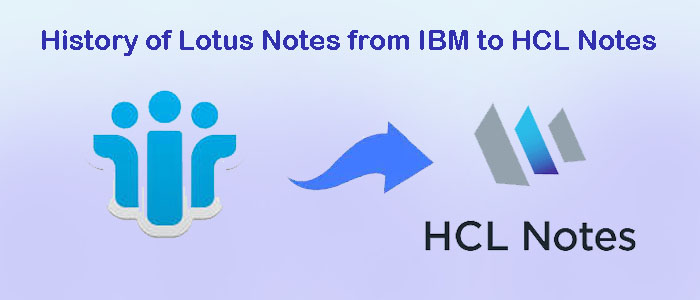Summary – In this blog, you will get complete information about the history of IBM Lotus Notes and we will also tell you what has been its journey since its inception to HCL Notes. In this blog, we have to explain all the IBM Lotus Notes versions since its release almost 30 years ago.
IBM Notes and Lotus Notes are now known as HCL Notes, it is a desktop client application, it is used for email and calendaring solutions for businesses and organizations, HCL Domino server is required for this. This is providing business collaboration tools to make microblogging websites, instant messaging, share files, business workflow, voice or video calls/conferencing, discussion groups, document libraries, and applications.
Besides Domino Server, In HCL Notes or IBM Lotus Notes application anyone can also add and configure a non-domino IMAP or POP email account. This is used to hold up the mailbox item, like emails, appointments, contacts, documents, attachments, to-do lists, tasks, etc. HCL Notes or IBM Lotus Notes use the Notes Storage Facility or NSF database file format.
The History of IBM Lotus Notes to HCL Notes
HCL Notes, the Lotus Notes was truly developed in 1989 by the Development Corporation. In 1995, IBM acquired Lotus Notes and create a new division of IBM called Lotus Notes Development.
In the initial stage of December 2018, an Indian Official from IBM announced the sale of its Lotus Notes Acquisition to HCL in a $1.8 billion deal.
And in July 2019 HCL formally acquired the IBM Lotus Notes.
Early Days and Development
We can see the History of Lotus Notes in the early 1970s, inspired by Plato Notes, Lotus Notes was developed, which was created in 1973 by David R. Woolley at the University of Illinois.
It was in 1984 that Ray Ozzie, who worked on CERL Plato’s system and was the founder of Lotus Development Corporation in the 1970s, formed Iris Associates to develop the first version of Lotus Notes to be done. Iris Associates and Ozzie handled product development at that time, and Lotus Notes Corporation led sales and marketing. Iris was acquired by Lotus Notes Corporation in late 1994. It was then that Mitch Kopor saw potential in Ozzie’s work.
Since then, the development of Lotus Notes started.
IBM Lotus Notes and HCL Notes deliver History-
Lotus Notes was created to include online discussion, contact, emails, and document database, due to which the developers had to face two challenges here.
- First is, Networking was very slow and rudimentary, which led the developer to set up Lotus Notes as a personal information manager with sharing capability.
- Second is, in its early stages of development, requiring developers to write a lot of system–level code to develop functions such as database and nameserver, and later became more capable as networking evolved. Lotus Notes later became groupware that facilitates applications that enhance coordination, communication, and collaboration between employees or users.
The first Lotus Notes release completely changed the way the business was done, and what happened afterward is history.
Did you know – the Head of Water House was so impressed with the first release of Lotus Notes that he was don’t waste his time and he brought 10,000 lines of Lotus Notes that he brought sale ever of PC Software product at that time?
Lotus Notes 1.0 Released – Year 1989
1989 first Lotus Notes shipped and wrote more than 35,000 lines of it DOS 3.1 or OS/ 2 required state for this.
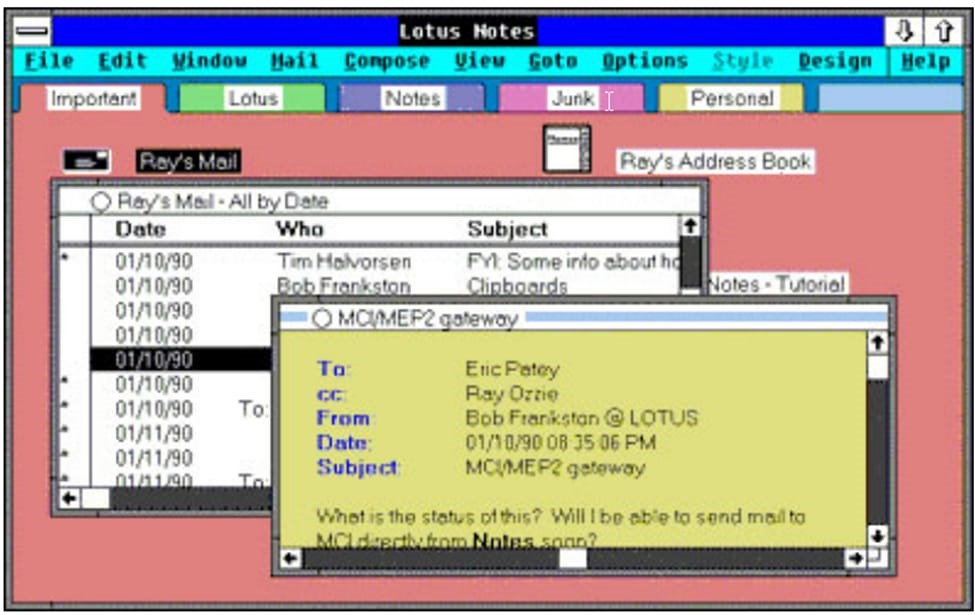
It offers the following revolutionary features in 1989. That is followed below.
- For the secure transmission of documents, it includes encryption, signing, and authentication via RSA public key. This was the first ever product which was to use for RSA Cryptography.
- Dial-up functionality is provided.
- Provides function of importing or exporting data.
- Access control
- Enhance the ability to quickly create users and mailboxes.
- Enhance the ability to send emails, receive return receipt notifications for new emails, and autocorrect misspelled names and words while drafting a message.
Minor update v1.1 was also released after 1990 with restructured code and portability layers issued.
Lotus Notes 2.0 Released – Year 1991
In 1990 there was a major release of Lotus Notes 2.0 central to scalability.
After the initial success, Iris Lotus supported 10000 users and also wanted to target more small and medium-level businesses in addition to targeting the company the result is happened is PC become more powerful and able to handle more users than before.
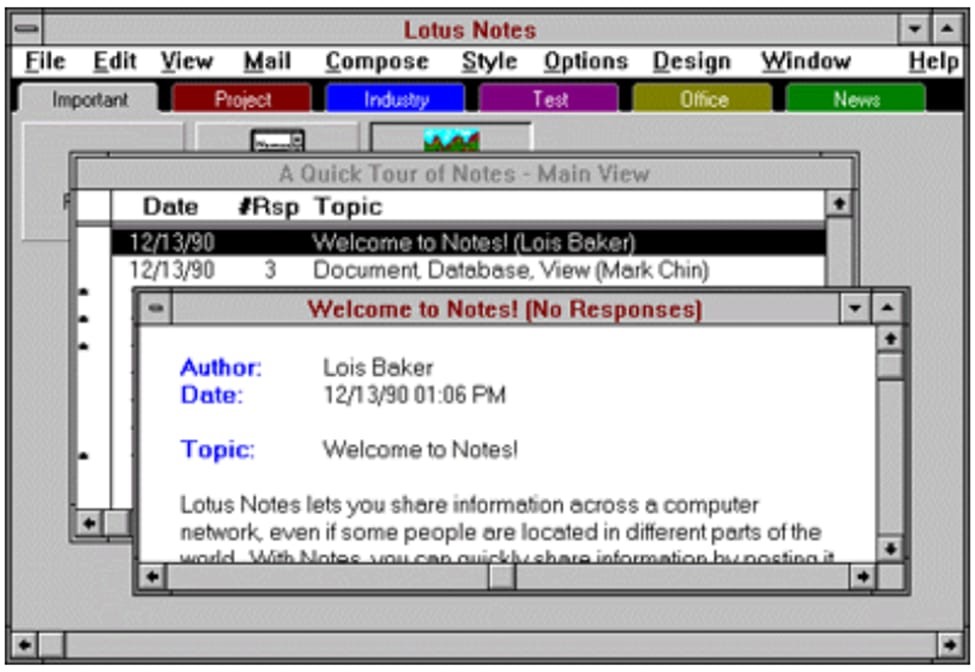
The good result was that organization started buying Lotus Notes in the 1990s.
Lotus Notes 3.0 Released – Year 1993
Lotus Notes was released in May 1992 with the Build number 114.3c indicating the Lotus Notes build was successful in 114 which took 3 attempts to complete the last build.
At the time Lotus Notes was used by more than 50,000 people and 2000 companies, while the only goal of releasing version 3.0 was to introduce cross-platform compatibility. The first series of rewrites was also displayed and it could be used by 200 users simultaneously.
Lotus Notes 4.0 Released – Year 1996
Lotus Notes 4.0 was released in January 1996 with a completely redesigned user interface, taking into account not only the appearance and user feedback but also simplifying the interface in many ways to make it easier for the user to use it. Easy to use and easy to manage.
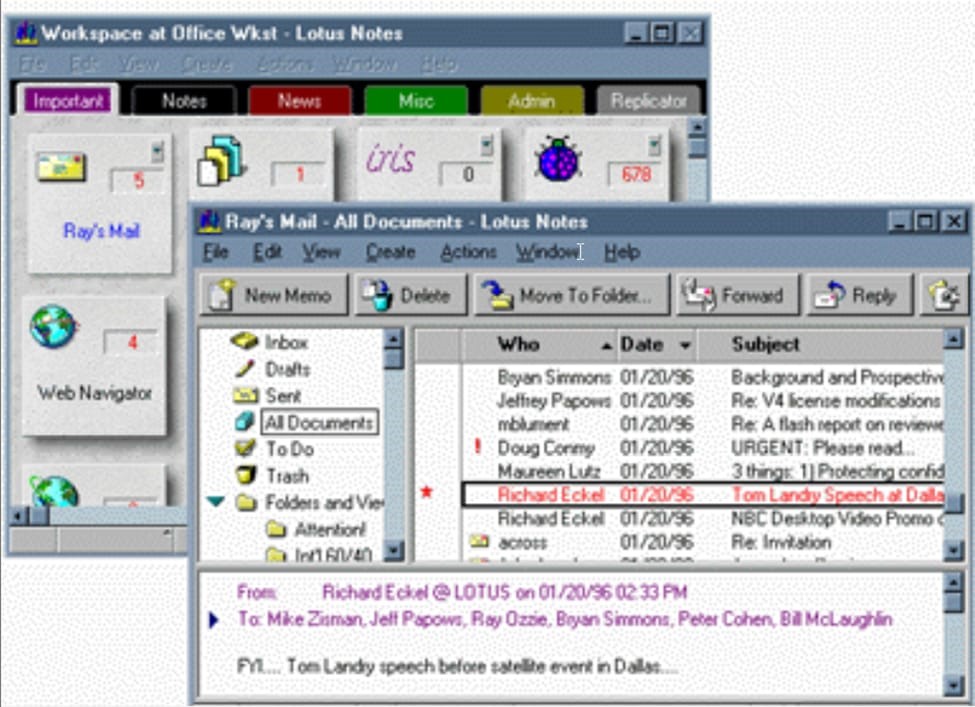
After seeing the importance of the web, it gathered many new web technology features that were even before popularized by Ray Ozzie. now users can convert inter notes documents into HTML pages and easily install them to display in the browser these elements played an important role in Lotus Notes’ success.
Lotus Notes 4.5 was released in December 1996 with the server’s name Domino, adding several improvements such as Native HTTP Server, support for POP (POP3) Server, SMTP/ MIME, Calendaring and scheduling, Java support, and mobile corporate directory.
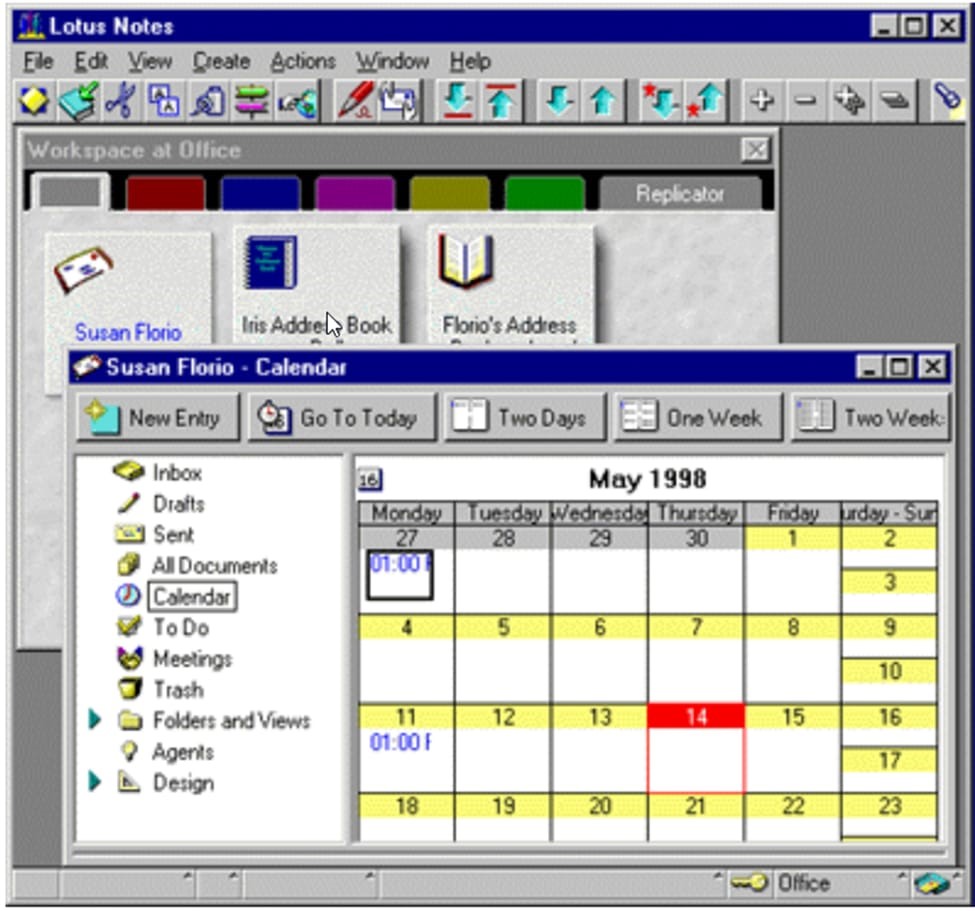
Lotus Notes 5.0 Released – Year 1999
In early 1999 Lotus Notes and Domino 5.0 was released in 1984 referred to as these 160 builds it incorporated parts of the architecture that dated back to version 1.0 and for 1.0 version issued power client.
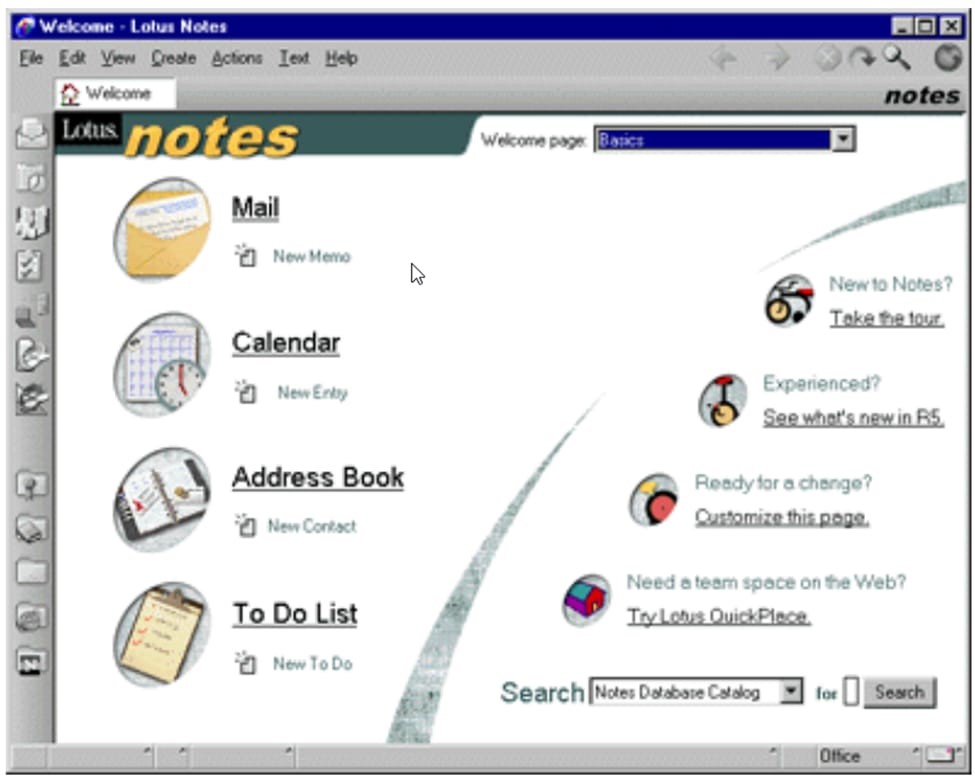
Lotus Notes 5.0 continued the integration and introduced a re-designed user interface to enhance the features of the browser type, it also supports a large number of internet protocols.
Lotus Notes 5.0 was to hand for the Unix, Netware, Windows NT, Windows 95, Windows 98, and OS/ 2 platforms.
Lotus Notes 6.0 Released – Year 2002
In October 2002, the Lotus Notes 6.0 was released alongside the Lotus Domino 6, at which time discussions of increased productivity, faster deployment, and lower cost of ownership were dominated. Domino’s 6 servers offered better forgiveness leadership and performance to reduce maintenance and administrative overhead.
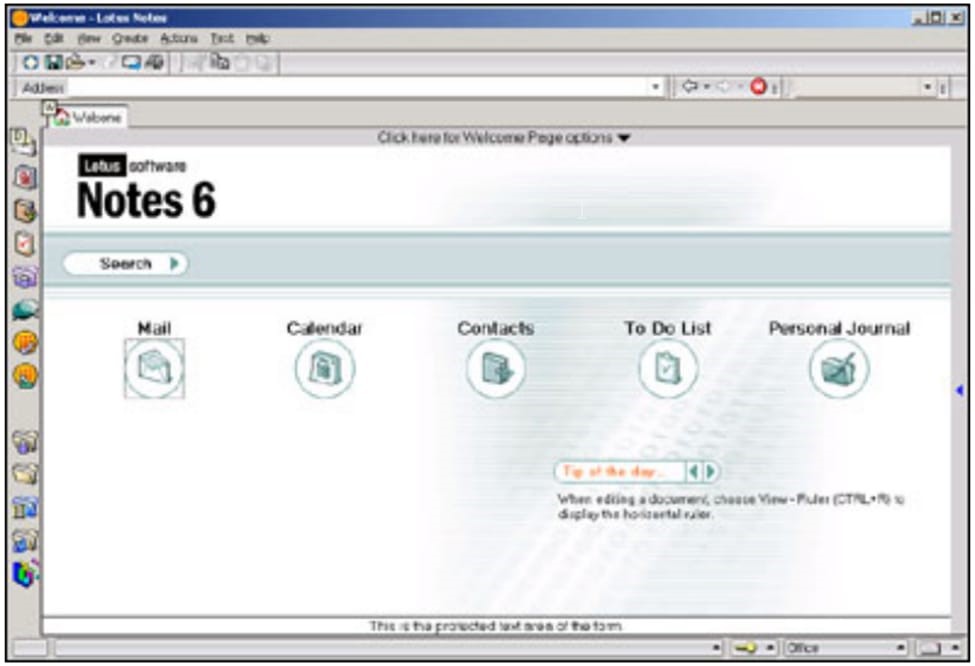
This code was reused to reduce development and purpose time to a faster version 6.0 was designed to help users manage time effectively and improve collaboration and calendaring and scheduling were also improved.
In September 2003 Lotus Notes 6.5 was released which now offers integration with IBM and Lotus Notes Technology such as IBML Lotus Domino, web access or iNotes web access, IBML Sometimes instant messaging, etc.
In this, the function of calendaring and scheduling was further improved, this was done so that the user would be able to create TO-DO items from the mail message by dragging and dropping the message.
Lotus Notes 7.0 Released – Year 2005
In August 2005 Lotus Notes and Domino 7.0 were Released to keep up making the Lotus Notes and Domino easier to deploy, manage, and administer with hardly any deep pockets. In addition, Lotus Notes 7.0 with IBM Web Sphere Portal and IBM DB2 technology were also integrated.
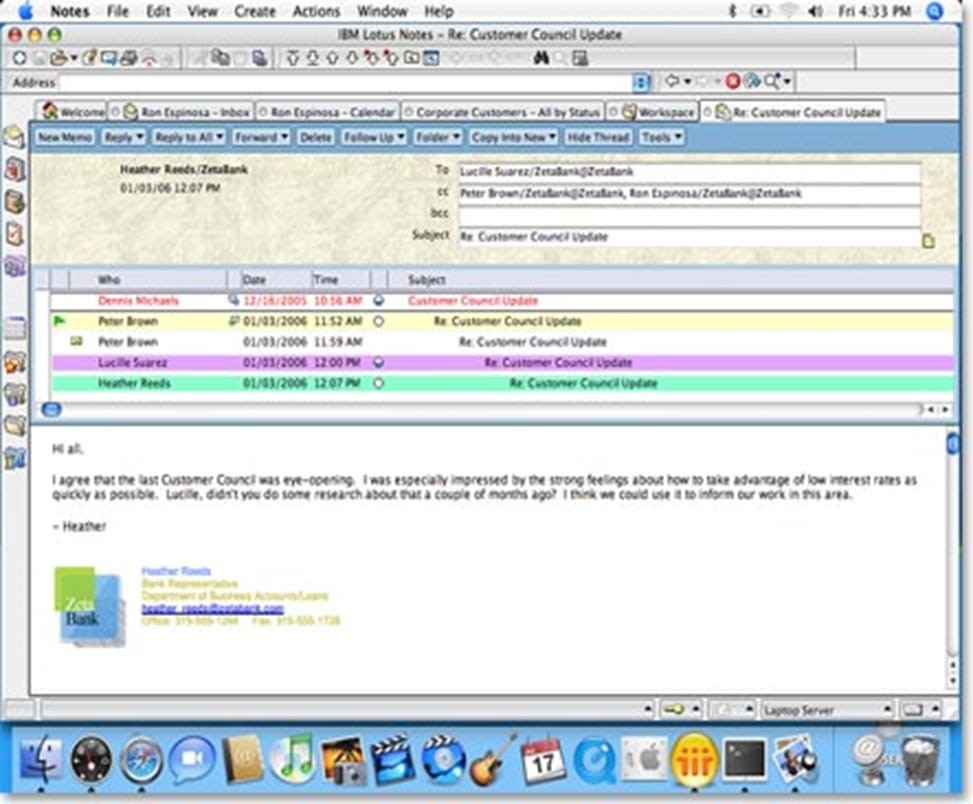
This version was always available for Windows, macOS, and Linux/ x86 (Red Hat and SuSE).
Lotus Notes 8.0 Released – Year 2007
In June 2005 Lotus Notes 8.0 and Domino 8.0 were announced at IBM LOTUS Notes Technical Forum. In August 2007 it was released with great improvement and change over the earlier version. After this real Lotus Notes become an open-source, java-based Platform.
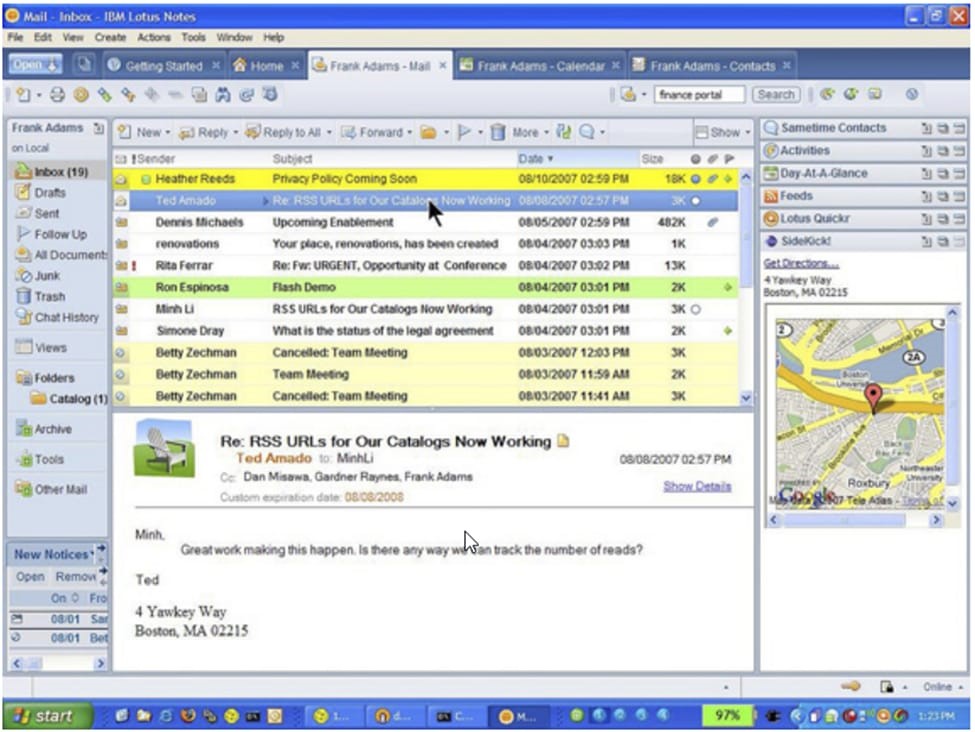
This builds a collaboration and messaging product with a redesigned user interface, extended support, new productivity, tools, and new functionality features.
On IBM Lotus Expeditor version 8.0 was built, this IBM’S Universal managed client software (this was built on Eclipse)
After a subsequent minor was released, IBM added support for Google gadgets, widgets, integrate viewers for Microsoft 2007 documents, stability enhancement, and several UI performances.
Lotus Notes 9.0 Released – Year 2013
In March 2013, Lotus Notes 9.0 was again come up to deliver with an updated GUI, brush up iNotes integration, IBM Notes Browser plug-in, and embedded application support. After this, minor updates were also released including bug fixes and features improvements, these also included support for windows server 2016 and ADFS 3.0 IN march 2017 with the 9.0.1 FP8 release.
Lotus Notes 10.0 Released – Year 2018
In October 2018, Lotus Notes 10.0 was a major release. Which is containing several feature improvements, Domino database enhancements to the cluster replication, performance monitoring interface, Domino Query Language, extension for database, etc.
Retrieving data is also included in it through REST API Via the HTTP Interface. This version also supports CentOS.
IN MAY 2019 Domino 10.0.1 FP2 ( Fix Pack 2) was also released, this version provides the facility the ability to configure cross-origin resource sharing ( CORS) that allows a web application from another origin to access the resource on any other Domino web server.
Lotus Notes was Rebranded to HCL Notes version 11.0 – Year 2019
When HCL Acquired IBM Notes then IBM Lotus Notes was rebranded to HCL Notes and released version 11.0in December 2019 with SwiftFile assistant integration. This was also come up with the option of 128- bits AES to encrypt the local database.
HCL Notes version 12.0 Released – Year 2021
in June 2021 This version was released, HCL Notes 12.0 and HCL Domino 12.0 get going the cloud-native deployment with a security option and flexible backup.
Conclusion
In this article, we are trying to give you complete information about the History of Lotus Notes from IBM to Notes. We are trying to provide you with complete information about the History of Lotus Notes from IBM to Notes in brief. If you work in any organization and your organization uses HCL Notes and HCL Domino or IBM Domino server for emails, collaboration, and calendaring and your organization needs to shift to Microsoft Exchange or Office 365.
Then our team is suggested you use an NSF to PST Converter tools, such as FixVare NSF to PST Converter. This software tool will help you to convert your NSF files to Outlook importable PST format quickly and safely. You can import to Exchange or Office 365 user files Via the Outlook import/ export wizard. By using this software, you may also export the email items from NSF Files directly to office365.

